Motherboard Tour
The board (again) has a black PCB (yawn) with blue and black colored components (double yawn). Boring, boring, boring; the contagious spread of black and blues amongst motherboard manufacturers is getting really old really fast.
Four DDR3 memory color coded for ease of installation and configuration of dual channel operation.
The 24 pin power connector is in its usual place, flanked on the side by power and reset switches. Not the best place on the board for placement of these switches (the lower left edge is the easiest to access), but they are there for you. Continuing along the front edge (a break from my traditional style of reviewing boards; lest I get boring as well!), we have the SATA ports -4 SATA 6 Gbps (grey and blue) & 4 SATA 3 Gbps; extra SATA 6 ports are powered by a Marvell controller. The LED diagnostic display completes the tour of the front of the board.
There are four 4pin PWM fan connectors on the board; 3 around the CPU area, one at the rear left edge of the board (looking from the front).
The Z77 PCH lies under a low profile ‘skull capped’ heatsink which should not interfere with long GPUs. Right behind the PCH is a PLX chip which provides extra PCI-e 3.0 lanes to power the second x16 PCI-e connector (electrical x8).
The board features two PCI-e 3.0 x16 slots one at full and other at half speed (i.e. X16 and X8 electrical). It also offers a single x4 PCI-e 2.0 port as well as 2 PCI-e x1 connectors as two conventional PCI ports. One of the x1 slots will be occupied by the bundled Wifi adapter.
The left edge of the board features front panel, USB 2.0 (6) and USB 3.0 (4) headers, as well as headers for audio and IEEE 1394. Right next to the PCI-e x4 slot are the set of diagnostic LEDs. This is the best place for these as it is the most visible area if your case has a window. They will tell you, at a glance, the health status of various onboard components. The HDD LED blinks to show activity and is blue in color.
The rear IO area has 4 USB 3.0 ports; 4 USB 2.0 ports (2 yellow color coded are for quick charging of your mobile devices); a single HDMI port; a bios recovery switch (handy); the usual audio ports as well as dual gigabit LAN (Intel powered) and IEEE 1394 and E-SATA ports.
The processor area is flanked by power regulation circuitry covered by a two piece heat-sinks setup. The board seem to be using a phase power regulation setup for the processor. The processor area offers enough space to use the largest of heat sinks (the board easily accomodates a Noctua NH-D14 with low profile memory). The 8 pin CPU power connector is at the located on the right edge next to the CPU socket.
Apart from the rather odd positions of the power and reset switch the board features a rather user-friendly layout. The diagnostic LEDs are easily visible (if you case has a window). All the headers are neatly organized on the left edge. What Intel could definitely do is include some form of “Q”-connectors to make the life of end user easy. Icing on the cake would be if Intel coud form a ‘standard’ for all motherboard manufacturers to follow so that when one switches board, one does not have to fiddle with teeny frontal panel connectors.
Synthetics
Sandra 2012
Sandra is a very competent stress testing and benchmarking suite.
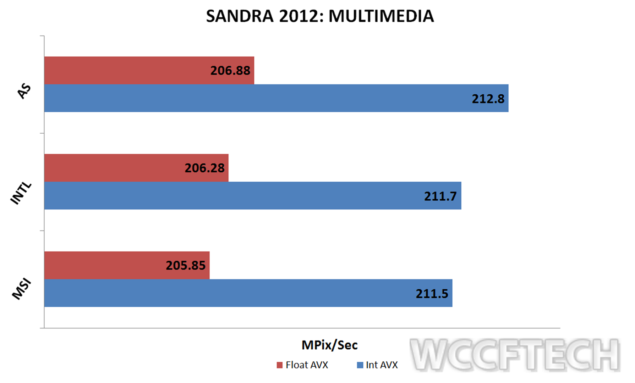
The results are fairly close to one another to call this a tie!
X264 HD V3 & Cinebench R11.5
This benchmark measures the encoding performance of the processor. It offers a standardized benchmark as the clip as well as the encoder used is uniform.
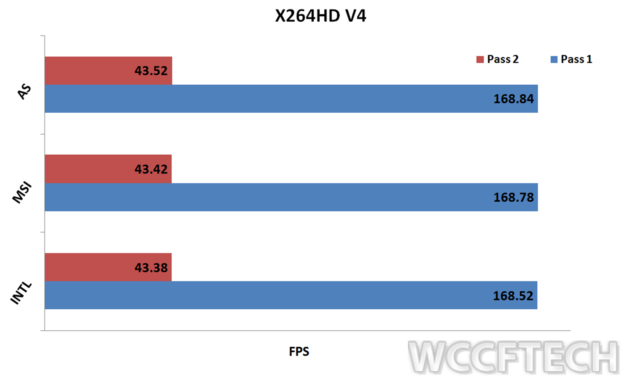
Cinebench is based on Maxon’s Cinema 4D. It is used to compare graphics as well as processor performance. We are using the CPU performance numbers for our comparison.
Try as you might, you will not be able to tell the boards apart if we were to remove the legend! The CPU determines performance.
3D Mark 11: Physics Test & Games
This is the latest incarnation of one of the oldest graphics benchmarking suites. The latest incarnation supports DirectX 11. It has a physics test that emulates physics on the processor.
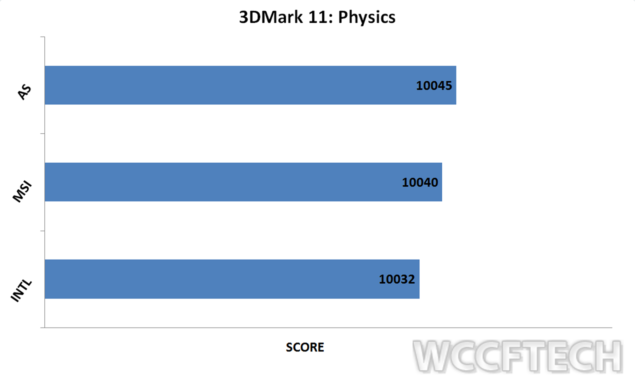
Yawn…. They are (nearly) all the same.
Testing
Testing motherboards is not an easy task. No matter what types of test are done the CPU’s performance does come into play. Testing IO is basically only testing the ability of the PCH. Thus what separates motherboards these days is their ability to provide functionality you need (read over clocking potential, RAID, multi GPU setup etc). But as the saying goes; when in Rome do as Romans do; we’ll put up some numbers to prove that we did spend time testing the board to dissect the ‘quantum’ difference between it and its peers!
System Specs
| Motherboard |
MSI Z77A-G43
ASRock Z77 Extreme6 Intel DZ77-GA-70K |
| Processor | Intel Core i7 3770K |
| Memory | G.Skill Sniper 2X4GB (1600 MHz CL9 @ 1.25V) |
| Hard Disk | Seagate Baracuda 7200.11 1TB |
| Power Supply | Thermaltake Tough Power XT 775W |
| OS | Windows 7 SP1 |
Test Suite
| Synthetic |
Sandra 2011
X264 Benchmark (HD V4) Cinebench 3D Mark 11: Physics Test 7-Zip Far Cry 2 Crysis: Warhead |
| IO Performance |
SATA – HD Tune
USB – Crystal Mark 3 |
Страница 1: Тест и обзор: Intel Desktop Board DZ77GA-70K
Первые процессоры Ivy Bridge от Intel вышли в конце апреля 2012 года. Но чипсеты были объявлены чуть раньше, чтобы производители материнских плат смогли подготовиться и представить свои продукты на чипсете Intel Z77. Конечно, среди производителей материнских плат особое место занимает сама Intel, и в нашу тестовую лабораторию поступила high-end модель DZ77GA-70K из линейки Extreme Series, от которой можно ожидать идеальное соответствие спецификациям Intel.
Популярность эталонных материнских плат Intel в последнее время увеличивается и среди энтузиастов, поскольку Intel начала встраивать различные high-end функции, которые раньше встречались только среди сторонних производителей, да и поддержка разгона тоже стала весьма проработанной. Так что материнским платам Intel сегодня уже нечего стесняться перед продуктами других производителей. Кроме того, никто не знает особенности своих процессоров лучше, чем Intel, поэтому от материнских плат можно ждать наилучшей совместимости и стабильности. В нашей статье мы рассмотрим, как новинка Intel покажет себя в сравнении с моделями других производителей.
С первого взгляда понятно, что Intel DZ77GA 70K ориентирована на high-end рынок. Материнская плата оснащена двумя физическими интерфейсами PCIe x16 третьего поколения PCI Express, хотя ко второму слоту подведено восемь линий. Впрочем, для конфигурации на двух видеокартах подведение восьми линий PCIe 3.0 к каждому слоту будет вполне достаточно. Другие функции тоже весьма достойны. Вы получите четыре порта USB 3.0 и четыре USB 2.0 на задней панели ввода/вывода. Встроенное графическое яро процессора задействовать можно только через выход HDMI. Для подключения накопителей доступны восемь портов SATA на плате, четыре из которых относятся к самому современному поколению SATA 6G. Цена материнской платы составляет около 230 евро в Европе или 8 200 руб. в России, что вполне приемлемо для high-end модели. Мы детально рассмотрим плату на следующих страницах.
Внешний вид Intel DZ77GA-70K
Функции материнской платы приведены в следующей таблице:
| Производитель и модель | IntelDesktop Board DZ77GA-70K |
|---|---|
| Розничная цена | около 230 евро в Европеоколо 8 200 руб. в России |
| Сайт производителя | Официальная страница Intel DZ77GA-70K |
| Функции северного моста/CPU | |
| Чипсет | Intel Z77 Express |
| Слоты памяти и тип | 4x DDR3 (Dual-Channel) |
| Объём памяти | Макс. 32 Гбайт (через 8-Гбайт DIMM) |
| SLI / CrossFire | CrossFireX, SLI (2-Way) |
| Интегрированные функции | |
| PCI Express |
2x PCIe 3.0 x16 (x16/x8)1x PCIe 2.0 x42x PCIe 2.0 x1 |
| PCI | 2x PCI |
| Контроллер Serial ATA, SAS и ATA | 2x SATA 6G и 4x SATA 3G с RAID 0, 1, 5, 10 через Intel Z77, 1x eSATA 6G2x SATA 6G через контроллеры Marvell 88SE9172 (PCIe) |
| USB | 10x USB 2.0 (4x на панели ввода/вывода, 6x через «косичку»)8x USB 3.0 через Intel Z77 (4x на панели ввода/вывода, 4x через «косичку») и Genesys GL3520M USB-концентратор |
| Графические интерфейсы | 1x HDMI |
| WLAN / Bluetooth | Wi-Fi 802.11 b/g/n, Bluetooth V2.1 |
| Firewire | 2x IEEE 1394a (1x на панели ввода/вывода, 1x через «косичку») |
| LAN | 1x Intel 82579V Gigabit LAN1x Intel 82574L Gigabit LAN |
| Звук | 8-канальный Realtek ALC898 аудио-кодек |
Как видим, функциональность у материнской платы вполне достойная. Помимо привычных интерфейсов вы получите Wi-Fi, Bluetooth и два порта LAN. По размеру материнская плата соответствует стандартному формату ATX.
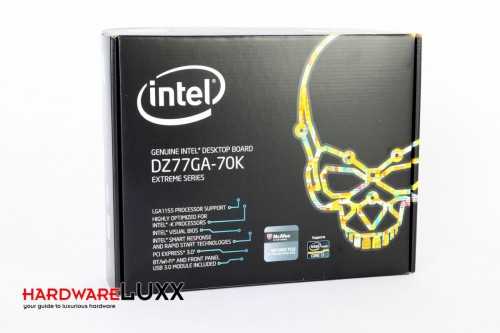
» Fotostrecke
Как можно было ожидать от Intel, коробка украшена знаменитым черепом. На ней же приводится список ключевых функций.
Комплект поставки Intel DZ77GA-70K следующий:
- Коврик мыши Intel
- Заглушка ввода/вывода
- Модуль для 3,5″ переднего отсека с двумя портами USB 3.0
- Мостик SLI
- Карта Wi-Fi и Bluetooth V2.1 USB 3.0 с антенной
- Руководство по быстрому старту
- Руководство пользователя по работе с WLAN
Комплект поставки
<>Тест и обзор: Intel Desktop Board DZ77GA-70KIntel DZ77GA-70K | Функции и раскладка (1)
Seite 1: Test: Intel Desktop Board DZ77GA-70K
Die Ivy-Bridge-Plattform von Intel ist bereits seit April diesen Jahres für jeden zugänglich. Seit diesem Zeitpunkt sprießen von den bekannten Mainboard-Herstellern die entsprechenden Modelle mit Intels Z77-Chipsatz. Zu den renommierten Mainboard-Herstellern gesellt sich selbstverständlich auch Intel selbst. Heute testen wir das High-End-Modell DZ77GA-70K aus den Extreme-Series, das sich an den eigenen Intel-Vorgaben orientiert.
Die Beliebtheit der Intel-Referenzboards wurde im Laufe der Zeit immer größer, nachdem Intel damit begonnen hat, wie die anderen Hersteller diverse High-End-Funktionen und Overclocking-Features zu integrieren. Unter anderem aus diesen Gründen stehen die Mainboards von Intel selbst den anderen Herstellern in nichts nach und konnten in der Vergangenheit schon Awards für sich gewinnen. Kein Wunder: Letztendlich kennt man die eigenen Prozessoren aus dem Eff-Eff und kann deshalb bestmögliche Platinen als Grundlage bauen. Wie es sich gegen andere Probanden schlägt, zeigen wir in diesem Test.
Man erkennt recht schnell, dass das Intel DZ77GA-70K auf den High-End-Markt ausgelegt ist. So bietet es zwei mechanische PCIe-x16-Schnittstellen der dritten PCIe-Generation, wovon der zweite Slot mit acht Lanes angebunden ist. Für ein Multi-GPU-Setup ist eine Aufteilung von zweimal acht Lanes dennoch ausreichend. Die restliche, großzügige Ausstattung kann sich sehen lassen. Gleich vier USB-3.0-Ports und vier weitere USB-2.0-Schnittstellen stehen über das I/O-Panel zur Verfügung. Für die Nutzung der IGP steht lediglich ein HDMI-Anschluss bereit. Darüber hinaus sind für Storage-Lösungen insgesamt acht SATA-Anschlüsse verlötet worden, von denen vier der aktuellen SATA-6G-Generation angehören. Der Preis von ca. 230 Euro ist für ein High-End-Modell auf normalem Niveau. Auf die Details wollen wir in den weiteren Seiten eingehen.
Intels DZ77GA-70K in der Übersicht
Die Features des Mainboards sind in folgender Tabelle ersichtlich:
| Hersteller undBezeichnung | IntelDesktop Board DZ77GA-70K |
|---|---|
| Straßenpreis | ca. 230€ |
| Homepage | www.intel.de |
| Northbridge-/CPU-Features | |
| Chipsatz | Intel Z77 Express Chipsatz |
| Speicherbänke und Typ | 4x DDR3 (Dual-Channel) |
| Speicherausbau | max. 32 GB (mit 8-GB-Dimms) |
| SLI / CrossFire | CrossFireX, SLI (2-Way) |
| Onboard-Features | |
| PCI-Express |
2x PCIe 3.0 x16 (x16/x8)1x PCIe 2.0 x42x PCIe 2.0 x1 |
| PCI | 2x PCI |
| Serial-ATA-, SAS- und ATA-Controller | 2x SATA 6G und 4x SATA 3G mit RAID 0, 1, 5, 10 über Intel Z77, 1x eSATA 6G2x SATA 6G über Marvell 88SE9172 Controller (PCIe) |
| USB | 10x USB 2.0 (4x am I/O-Panel, 6x über Header)8x USB 3.0 über Intel Z77 (4x am I/O-Panel, 4x über Header) und Genesys GL3520M USB Hub |
| Grafikschnittstellen | 1x HDMI |
| WLAN / Bluetooth | Wi-Fi 802.11 b/g/n, Bluetooth V2.1 |
| Firewire | 2x IEEE 1394a (1x am I/O-Panel, 1x über Header) |
| LAN | 1x Intel 82579V Gigabit LAN1x Intel 82574L Gigabit LAN |
| Audio | 8-Channel Realtek ALC898 Audio Codec |
Die Ausstattung kann man als komplett bezeichnen. Neben den üblichen Anschlussmöglichkeiten sind selbst WLAN, Bluetooth und gleich zwei LAN-Anschlüsse vertreten. Die Mainboard-Größe entspricht dem gebräuchlichen ATX-Format.
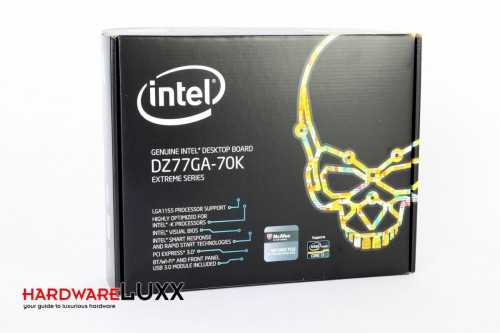
» Fotostrecke
Wie man es von Intel gewohnt ist, befindet sich auf der Verpackung selbst der bekannte Schädel. Zusätzlich sind dort die Top-Features aufgelistet.
Der Lieferumfang des Intel DZ77GA-70K sieht folgendermaßen aus:
- Mousepad von Intel
- I/O-Blende
- 3,5 Zoll USB 3.0-Frontpanel mit zwei USB 3.0-Anschlüssen
- SLI-Brücke
- Wi-Fi PCIe x1-Karte mit Antennen
- Quickstart-Guide und Bluetooth-Modul V2.1 (über USB 3.0)
- Anleitung zur WLAN-Antenne
Der Lieferumfang des Mainboards
<>Test: Intel Desktop Board DZ77GA-70KFeatures und Layout (1)
EFI\Bundled Software
One of the high-lights of the board is the inclusion of a GUI EFI. Intel calls this the ‘Visual BIOS’ and though Intel was one of the last manufacturer to bid adieu to the text based BIOS (Gigabyte comes to mind), its entry is right up there with the best (at-least in terms of what is displayed on-screen).
The home screen offers the basic board, processor, system and chassis info. While this is not the best home screen it does offer quiet a lot of useful information. Intel could add temperature information to improve the home screen experience while removing chassis and system info as most end-users will find these tabs least useful (and empty) most of the times.
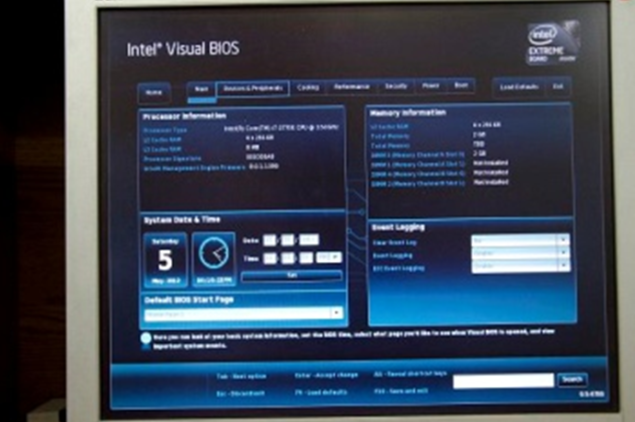
The main screen lists processor (clocks, cache, ME and signature), memory (Cache, onboard), event logger and system time and date. Again not the greatest main screen but a step in the right direction.
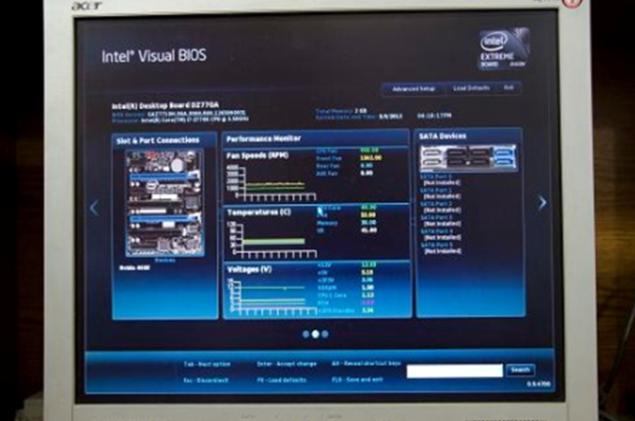
It is possible to switch to a more basic EFI suitable for novices which hides advanced features of the EFI
The devices and peripherals screen is divided into 3 sections; USB, SATA and Graphics & Others. The first two are self-explanatory, while the third offers control over integrated GPU functions as well as other peripherals on the board (LAN, Audio, IEEE 1394).
The cooling screens, divided in monitoring, fan speeds, temperatures and threshold are very well done. The first shows the various environment parameters (fans, temperatures, voltages), whilst the second offers fan speed control.
The performance screen is where all the over-clocking controls are located.
The summary screen shows the processor, memory and integrated GPU clocks, voltages as ‘proposed’ (what has been set), ‘active’ (what is achieved) and default (default setting). This is true for all settings shown here. While this is useful information, it is very different from other EFI implementation and do feel a little alien and confusing at first.
The processor tab of performance settings allow for a simple slider control of processor speed (think of this as idiot over-clocking), while the panel above the slider and the right panel allow for an in-depth control. When using the slider the CPU parameters are automatically setup by the board.
The memory over-clock options as well integrated GPU over-clock options are similarly setup –a slider based control as well as more individualized controls.
The EFI is definitely an improvement over the drab BIOS that Intel has produced in the past. In fact it seems as if for once Intel has really put some thought into design of the UI as it is actually very easy to work with. Some of the performance screens are still typical ‘Intel’, but once you get to know the ropes, even those are not that hard to figure out.
Conclusion
As you can it is difficult to base purchase decisions on results of benchmarks alone. What will help you decide are features that the board has and you might have use for and maybe the over-clocking potential. The Intel board comes with enough goodies (USB 3.0 front panel box, Wifi adapter, Blue tooth module) and features (2 PCI-e 3.0 slots; LEDs; onboard buttons; 8 USB 3.0 ports; dual gigabit LAN, visual bios) to be considered a viable purchase option. However it is not the best over-clocker available (maybe a restriction of our preview board?). But deciding a motherboard purchase on over-clocking alone is not the wisest thing to do.
One thing that I would like to add is that this board was stable throughout the tests, both at stock and over-clock. We did not have one single crash which is something I have come not to expect out of enthusiast class Intel boards in their review-sampling stage.
Motherboard: Quick Facts
| Socket | LGA 1155 |
| Processor Support | All current LGA 1155 processors |
| Segment | Enthusiast |
| Size | ATX |
| Memory |
DDR3 4 Slots/ 32GB
Supports speeds in excess of 1600MHz (with 22nm CPUs) |
| Features |
Visual EFI (BIOS)
Onboard Power & Reset buttons Onboard Diagnostic LEDs and LED Display |
| Slots |
1 x PCIe 3.0 x16 slots @x16 speed
1 x PCIe 3.0 x16 slot @x8 speed 2x PCI Express 2.0 x 1 connectors 1x PCI Express 2.0 x4 connector 2x PCI Connectors Supports XFire as well as SLI |
| Over-clocking | Yes (Both Processor and Graphics Core) |
| I/O |
4x USB 3.0 ports
1x Firewire 4x USB 2.0; 2x Hi-Current (Yellow) 2x Intel Gigabit LAN 1x BIOS recovery button 1x HDMI 1x E-SATA 7.1+2 (multi-streaming) Audio. |





























